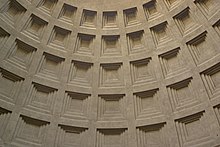Lacunar
Lacunar ( latin "paneled ceiling", Ita. "Lacunari" or "cassettone" Pl. "Cassettoni"), in Greek Phatnoma ( φάτνωμα ) in the architecture of antiquity referred the recessed cassettes located between the intersecting beams of the ceiling are located. Lacunar refers to the individual cassette, Lacunaria the cassette ceiling (corresponding to φατνῶματα Phatnomata in Greek).
Originally only in the Greek temple as the form of the wooden ceiling of the cella , later modeled in stone (e.g. in the passageways) (for example in the Parthenon , where the cassettes measure 3.43 × 1.26 meters and weigh 3½ tons). Taken over by the Romans in the construction of vaults, arches and domes (for example the dome of the Pantheon ) or the vestibule of the mausoleum of Diocletian in Split .
Further meaning
Vitruvius also mentions ( de architectura 9.8.1) a clock invented by a certain Skopinas from Syracuse - plinthium sive lacunar . Apparently a sundial attached to a rectangular frame .
literature
- Christoph Höcker : Metzler Lexicon of Ancient Architecture. 2nd edition Metzler, Stuttgart 2008, ISBN 978-3-476-02294-3 . P. 155
- Walter Hatto Gross : Lacunar. In: The Little Pauly (KlP). Volume 3, Stuttgart 1969, column 441.
- Vitruv de architectura 2.9.13, 4.6.1

